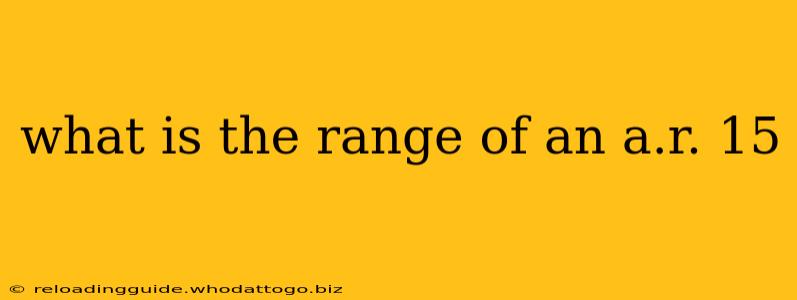The effective range of an AR-15 is a complex question, depending heavily on several factors. There's no single definitive answer, as "range" can refer to different aspects of firearm performance. Let's break down the nuances to provide a clearer understanding.
Maximum Range vs. Effective Range
It's crucial to distinguish between the maximum range and the effective range.
-
Maximum Range: This refers to the farthest distance a bullet can travel before hitting the ground. For an AR-15 using standard 5.56 NATO ammunition, this can extend to over 3,000 yards (approximately 1.7 miles). However, at these extreme distances, the bullet's trajectory is highly unpredictable and its energy significantly reduced.
-
Effective Range: This is a far more practical measure. It signifies the distance at which a shooter can consistently achieve accurate and reliable hits on a target. This depends not only on the rifle but also on the shooter's skill, the ammunition used, and environmental conditions like wind. For the average shooter using an AR-15 with standard 5.56 ammunition, the effective range is generally considered to be around 500 yards (approximately 457 meters) for a point target.
Factors Affecting Effective Range
Several factors significantly influence the effective range of an AR-15:
1. Ammunition:
Different types of 5.56 NATO ammunition will have varying ballistic properties, affecting their trajectory and energy at distance. Heavier bullets generally have a flatter trajectory but may be more susceptible to wind drift. Match-grade ammunition designed for accuracy will perform better at longer ranges than standard military-grade rounds.
2. Barrel Length:
A longer barrel allows for more complete powder burn, resulting in higher muzzle velocity and improved accuracy at longer distances. Shorter barrels will have a reduced effective range.
3. Optics:
The quality and magnification of the optic significantly impacts a shooter's ability to accurately engage targets at longer ranges. A high-quality scope with appropriate magnification allows for better target acquisition and precision at distances beyond the capabilities of iron sights.
4. Shooter Skill:
The shooter's proficiency is arguably the most critical factor. Experience, proper training, and understanding of ballistic principles are essential for consistent accuracy at longer distances. Factors like proper breathing techniques, trigger control, and stance greatly influence effective range.
5. Environmental Conditions:
Wind, temperature, and humidity all affect bullet trajectory. Strong winds can significantly deflect a bullet's path, decreasing accuracy. Temperature variations also alter the velocity of the bullet.
Conclusion:
While an AR-15 can send a bullet a considerable distance, its effective range for most shooters is significantly less than its maximum range. The effective range is generally accepted to be around 500 yards under optimal conditions and with a skilled marksman. This number is heavily influenced by factors such as ammunition, barrel length, optics, shooter skill, and environmental conditions. Always prioritize safe and responsible firearm handling practices. This information is for educational purposes only and should not be considered a guide for actual shooting. Always consult with a qualified firearms instructor for proper training.

